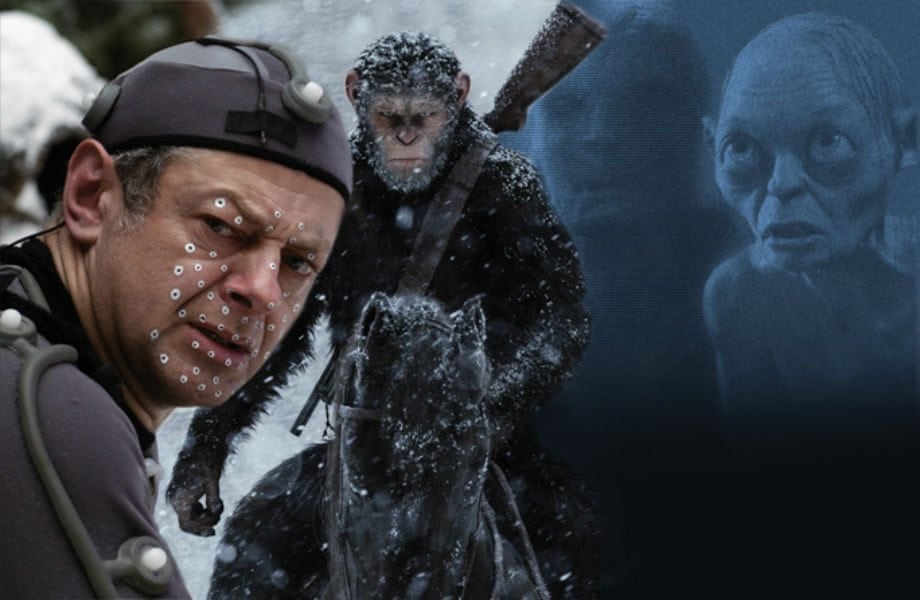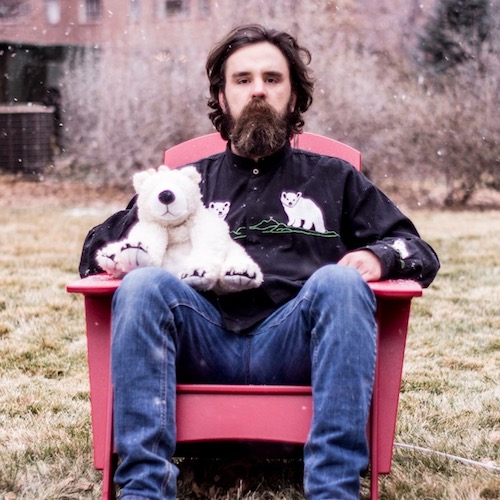An obsessive cave-dwelling creature. A giant gorilla rampaging through the city. A super-intelligent human-like ape. A mysterious villain perched on a throne. Behind each unique character is a man donning a skintight suit and face-tracking dots. A man none other than Andy Serkis, the master of motion capture.
As one of Hollywood’s most multi-faceted actors, Serkis enjoyed a long career in the theater before moving in front of the camera. Since his breakthrough role as Gollum in Lord of the Rings, Serkis has played major roles in a multitude of blockbuster franchises, including Caesar in Planet of the Apes and Supreme Leader Snoke of the newest Star Wars series. Though Serkis found his niche in performance capture, he has also participated in many live action roles. Throughout his career he’s played an assortment of characters ranging from the punk rock star Ian Dury in Sex and Drugs and Rock and Roll to Nikola Tesla’s assistant in The Prestige and, most recently, Ulysses Klaue in the Marvel Cinematic Universe.
Serkis has also expanded his already impressive career into directing. He helmed The Hobbit films as well as 2017’s Breathe. Currently, he is directing his own adaptation of The Jungle Book, set to release in 2018. He’s even done voice acting and direction work for a large collection of video games. We had the opportunity to speak with Serkis about his extremely successful career in performance capture, as well as some of the unique characters he’s played and his current work on The Jungle Book.
Innovation & Tech Today: Do you think you could briefly explain performance capture and how it works, at least on your end?
Andy Serkis: Performance capture is the application within the entertainment industry, and that has grown over the course of the last 20 years. Basically, the nub of it is that it is a series of cameras which run alongside film cameras. So, traditional film cameras film the performance, but then you have another set of cameras, which are 360-degrees around the area that you are working on set. These cameras pick up information from markers on a suit that you wear, and the markers are basically tiny little three-dimensional tracking markers, which are essentially individual GPSs that track movements throughout your body very specifically.
You wear also a head-mounted camera, and markers on your face – usually around 50-60 – and these track all of your facial expressions and the facial performance. It tracks the movement of the eyes, because of the definition of the eyelids, where the eyeballs move, and so forth. It’s another way of recording an actor’s performance. That’s it in a nutshell.
I&T Today: Have you seen any major changes or improvements in performance capture, and have they changed your methods?
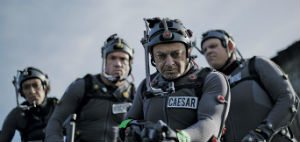
Two or three major jumps along the way have been being able to work outside of a motion capture volume, which is typically a sort of black box theater with all these cameras, where you have proxy elements of set pieces that you work on to relate to the environment. Whereas now, for instance, on the last Planet of the Apes films, we were able to take that technology outside, shoot on location on real sets, out in the wilderness, in rain, snow, et cetera, et cetera.
So, that is a technological improvement. That was really the way that the use of the markers has changed, from being retroreflective in the volume, as we call it, inside this black box space, to infrared pulsing markers that are tracked. So wherever you put the cameras, if they’re in the trees, or out on location, whatever. That has been a big improvement.
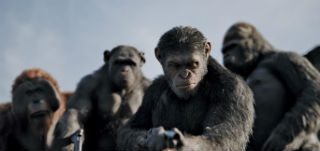
Obviously, their software has been invented for rendering fur, texturing eyes, skin, how snow falls on fur, how water falls off of the fur, et cetera. All that has changed over the years. And just, as they say, the acquired skillset of animators who have worked very closely, particularly WETA, the visual effects company that did this movie, who I have a long association with, who know my face from many, many roles, and know all the social expressions, where the muscle groups are, how my face deforms when I’m expressing a particular emotion.
That has all improved…and the actor’s performance is clearly honored to a very high level.
I&T Today: What has it been like to participate in so many different blockbuster franchises? Lord of the Rings, Planet of the Apes, the Marvel Cinematic Universe, Star Wars. How do you handle being in so many different universes, playing so many unique characters?
Andy Serkis: I suppose it comes from my early days in theater. When I started acting, I was really lucky to be part of a repertory company, and my very first experience and my education in theater was rehearsing one play during the day and performing another at night. My first job I did 14 plays back to back, and it was…I suppose I really loved it, the notion of being able to get deeply into the character, but then also be working on something else.
I’ve never hugely struggled with multitasking, but what has been incredible was working, when I did work originally on Lord of the Rings, [and] suddenly discovering this technology that allows you to completely disappear into the character, into a level of disguise, into a level of otherness and becoming something else which is unprecedented. That is why I’ve stuck with working with performance capture technology, that has led to this franchise, other franchises.
Basically, at the end of The Lord of the Rings, I thought my life would go back to conventional live-action film acting and theater, but Peter Jackson asked me if I wanted to play King Kong, after having played Gollum, and I said, “Wow, this is extraordinary. This is about the end of typecasting as we know it. You can play anything.”
I&T Today: So, a big part of developing any character, whether it’s live action or performance capture, is really developing the voice and how that character sounds. Gollum’s voice is so iconic. What is your process? How do you go about creating a voice for a character?
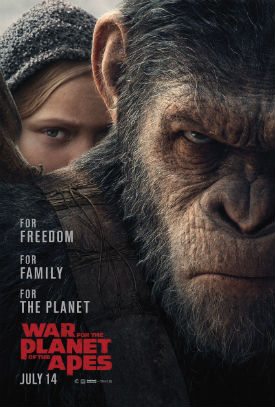
For instance, with Caesar, I’ve had an extraordinary journey because, of course, I’ve played him all the way from being an infant chimpanzee to being an almost human-like ape. He has linguistically evolved over the course of three movies. In the early forms of Caesar’s speech, it was very prototype human language, based on urgency coming from emotion. When he’s first screaming, “No,” for instance, in the first film, it’s a particularly guttural ape sound, but it’s formed through human words.
I&T Today: Speaking of Gollum, Caesar, and King Kong, you’ve played so many non-human characters, but you’ve been able to put so much emotion into them. What is that process? How do you put so much emotion into these creatures, and make them so complicated?
Andy Serkis: That really is the great thing about the technology. You can play in a very nuanced way. You’re not stuck behind a mask, layers of prosthetic makeup, where you’d have to fight through all those artifacts. You’re able to really play the internal creature, the character. It’s always about finding the human connection to them, how you choose to anthropomorphize those roles.
You always look for the human connection, and you’re always putting yourself under the microscope, too.
I&T Today: You’ve started to expand into directing. You directed the Hobbit movies, this year’s Breathe, and 2018’s Jungle Book. How have you enjoyed being behind the camera, rather than in front of it?
Andy Serkis: I adore it. I’ve been wanting to work as a director for many years. In fact, before I became an actor, I was a visual artist. I always had an appreciation for the overall aesthetic and beauty and storytelling from outside, as well as from inside, a single character.
I really do absolutely love working with actors, and eliciting and helping them to elicit the performance. I love creating, supporting the drama through camera choices. I think very visually, so it’s very much a natural progression for me, really. I’ve been very lucky with the projects I’ve been able to work on.
I&T Today: You’ve had such a multi-faceted career. Stage acting, performance capture, conventional acting, directing, voice acting. I was wondering, do you have a favorite mode of storytelling?
Andy Serkis: I don’t, actually. I get engaged with whatever project I’m working on at any given time. It is all about the script; it is all about storytelling. So I wouldn’t [say], “Oh, I’m going to do this live-action film because it’s a live-action character.” The choice is always based around, “Is this a great character? Is this something that speaks to me personally, or is the story important and will [it] connect with the world in some way?”
I&T Today: You’ve played so many different characters. Do you have a character that you connected with the most?

Andy Serkis: Oddly enough, Caesar. I thoroughly enjoyed playing that character, because of the journey that he’s taken all the way through, being a chimpanzee…The multi-faceted aspects of this character, not just the embodying of a chimpanzee, but to take it right through, it is that whole evolution. To play that aspect, keeping it real, and believable, and emotionally connective, and also leading the audience through the series, really. Showing them the world through the apes’ eyes. I have a real affection for Caesar.
Gollum, too. Gollum, because he started me off on this bizarre journey, and I wouldn’t be here without him, really. So I have quite an affection for that character, too. But I also loved the live-action roles. I loved playing Ian Dury in a film called Sex and Drugs and Rock and Roll. That was really, really a great and amazing character, this proto-punk guy.
I&T Today: What can people expect from your adaptation of The Jungle Book coming next year?
Andy Serkis: Our version of Jungle Book is very much closer tonally to Rudyard Kipling’s original story. In the book, it is much more of a psychologically complex and savage world, in a way, Mowgli’s world. And it’s a Mowgli-centric story, of a boy on the cusp of teenagehood, really. But also, appreciably, the difference with ours is that it’s a drama, really. There are spectacles, of course. The animals are performance captured, and it’s very much about the dramatic and emotional connection between Mowgli and the animals…The scenes take place in relative close-up, and they are quite powerful emotional scenes. And that’s been a huge challenge, because it’s complex enough to translate the actor’s performance onto an ape’s face because the physiognomy is fairly similar. It’s humanoid, whereas you’re translating the face of an actor onto a panther or a tiger. That’s a completely different challenge.


